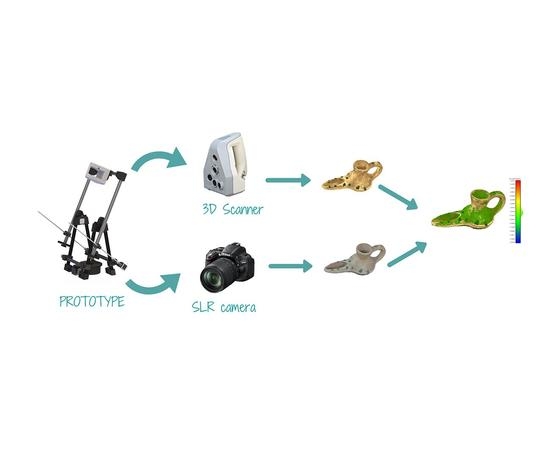Low-Cost Prototype to Automate the 3D Digitization of Pieces: An Application Example and Comparison
Abstract
:1. Introduction
- Robotic arms [23]: They automate the process of obtaining data, they are mainly used with the 3D scanner, they position the digitizing equipment making turns and movements around the object.
- Turntables [24,25]: They are widely used in both 3D scanner [26] and photogrammetry [27]. Mainly, its operation is based on the automatic or manual rotation of the platform to prevent the operator from moving around the model, so he can remain static. A system, exclusive for photogrammetry, has also been found in the bibliography, consisting of an automatic rotary table and a manual rotary arm with three predetermined vertical angles and manual focus distance tuning [21].
2. Materials and Methods
2.1. Preliminary Study of Movement
2.2. 3D Design and Prototyping
- (1)
- Gear Table: This is a helical gear designed to ensure smooth movements; its double helical shape avoids the axial thrust, a problem that can be found in ‘single’ helical gears. The manufacture of this type of gear is expensive by traditional methods. However, additive manufacturing has not a high cost.
- (2)
- Cradle bearing table: A cradle is done to accommodate the turntable bearing. The cradle is designed with the same inclination as the bearing, creating a perfect fit.
- (3)
- Bearing closure table (Outside diameter): This upper closure prevents that the bearing can get out.
- (4)
- Bearing closure table (Inner diameter): It is the lower close of the bearing, allowing their movement, but avoiding ejecting.
- (5)
- Table supplement: A supplement of the turntable is designed to adjust to the measurement of the chosen engine.
- (6)
- Engine supplement: This is a piece of engine adjustment used to make the gear pinion-motor spin with the gear table.
- (7)
- Gear Engine: The pinion of the turntable, designed in conjunction with the gear table, is double helical so as to overcome the problem of axial thrust helical single gear.
- (8)
- Support structure: It performs its function as it supports the soil which stiffens the structure, allowing the fixing of aluminium profiles.
- (9)
- Top Union: The connection piece and the rotation centre are responsible for attaching the rigid structure with the moving part.
- (10)
- Union structures: They consist of the joints between the aluminium profiles, to form the backbone of the machine and to stiffen.
- (11)
- Upper elbow: Higher elbows have a function of distance adjustment for different models of cameras and 3D scanner, anchoring the top post at the same time.
- (12)
- Support 3D scanner/camera: It is a top bracket to support the 3D camera or 3D scanner.
- (13)
- Counterweights stops: The adjustable stops serve to fix the weights balancing structure according to the mounted device.
- (14)
- Head electric piston: This allows the passage of the rods and it is articulated, achieving the simulation of the function of a piston.
- (15)
- Rotating rots piston unions: It is the coupling between the rotating bars and the electric piston head.
- (16)
- Lower joint piston: This is the coupling between the fixed structure and the threaded piston electric barillas.
- Maximum working dimensions 400 mm × 400 mm × 500 mm. Customizable mean replacing aluminum profiles.
- Turntable with 60 kg capacity and unlimited horizontal rotation.
- Vertical angle of rotation (pitch) of 120°. As noted above, the object must be flipped if the geometry of the entire object is to be captured.
2.3. Structural Components
2.4. Electronic Components
- Arduino Mega 2560: It is a printed circuit board with a microcontroller with digital and analog input/output.
- Ramps v1.4 Arduino expansion board: It is designed to accommodate all the components, inputs and outputs of the 3D printers.
- Pololu Set Purple: Drivers are stepper motors.
- Stepper motors Nema 17, 1.8° pitch angle (200 steps per revolution): Two motors in the corresponding pin of the Z axis are responsible for the optical equipment rotation, and in the X axis, one is responsible for the rotation of the movable table (Figure 5).
- Power Supply of 12 V and 30 A: It is responsible for feeding the system.
- Elimination of temperature controls, since if a probe is not detected in the printer, it would return an error and do not load movements.
- Change the rotation speed of the motors and their conversion to real angles.
- The spindle motor table stops are removed.
- The stops on the spindle motor of the optical system was modified too.
- Three Nema 17 stepper motors (40 €)
- Aluminum profiles (60 €)
- ABS filaments (30 €)
- Bearing (25 €)
- Small mechanical and electrical auxiliary components (20 €)
2.5. 3D Capture Equipment
- -
- 3D scannerThe scanner selection should serve a dual role:
- Verify the results obtained by the photogrammetric system, so a scanner with a precision below 0.1 mm, should be used, for the objectives pursued.
- Using a 3D scanner is not an easy task and requires an experienced operator, where multiple operators will not scan in the same way. Being able to use it automatically and always the same way is a very ambitious goal that the system is capable of achieving.
- -
- Photogrammetry
2.6. Data Collection
2.6.1. Scanning Using Prototype and Artec Spider Scanner
- Scanner warm-up time: 30 min, according to manufacturer’s specifications to ensure good accuracy.
- Distance: the scanner distance to object was set in 260 mm. The spherical movement is the responsible for keeping the maximum and minimum values within the scanner range.
- Scanning time: 13 min.
2.6.2. Scanning Using Prototype and DSRL Camera
- Camera heating time: the camera does no need heating time, but it need prior calibration for the lens and focal length chosen for the job The Agisoft Lens software [40] is used to calibrate the camera, taking into account that the calibration is only valid for the chosen focal length. The process is described below
- A calibration chessboard pattern is placed on the base of the system (turntable platform).
- The camera is placed in the system and 21 photographs are taken (three are the minimum for calibration). To obtain the images, the indications of the software will be taken into account:
- ▪
- Dazzling light sources will be avoided.
- ▪
- The photo area should cover the entire calibration pattern.
- ▪
- Maintaining the working focal length
- Distance: The distance is set in 450 mm. The spherical movement is responsible for keeping within the maximum and minimum field of view of the target values.
- Scanning time: 10 min.
- Retrieved file: 180 pictures with 4928 × 3264 pixel and .jpg format occupying 756 MB. Although it is recommended, they have not been obtained in raw form (raw camera data) to speed up working times.
- 60 mm focal length selection: with this distance the camera is calibrated.
- ISO-200
- Shutter speed of 1/60 s.
- 80% overlap of photos.
2.7. Edition of 3D Meshes
2.7.1. Artec Spider Scanner with Software Artec Studio 11
- (1)
- Connect the scanner to power and the control computer.
- (2)
- Place the scanner in its working range, this range can be checked in the scanner window preview.
- (3)
- After 30 min of warm-up of the scanner, speed tests are carried out to program the G-code file, determining the range of speeds allowed by the scanner.
- (4)
- Loading the G-code file in the system with the speeds established in the previous point.
- (5)
- Choosing the scanner configuration for data acquisition.
- -
- Scans alignment
- -
- Registration: Through algorithms, the positioning of the scans obtained is optimized.
- -
- Eliminate Noise
- -
- Fusion: Create a single surface model from the multiple surfaces obtained during the scan.
- -
- Postprocessing
2.7.2. Photogrammetry with DSRL Camera
- Upload photos: Uploading the photos consists of selecting the folder where the photographs taken are located. This folder must contain only the correct photos.
- Selection of calibration and reference points: Markers are used on the platform to scale the system; these markers are automatically recognized by the software. The coordinates of these markers have been taken with a Hexagon Romer arm with a precision of 0.03 mm.
- Alignment: To align the images, the Accuracy parameter will be selected as high to work with the original image resolution. This setting will require more processing time but will allow us better precision. The “key point limit” and “tie point limit” parameters, are kept at their default value.
- Creation of the point cloud: To generate the dense point cloud, the medium level parameter is selected because a higher quality requires a higher processing time. Once the mesh is generated, noisy points are fixed and cleaned manually.
- Mesh creation
- Surface type: Arbitrary (3D)
- Source data: Dense cloud
- Face count: High
- Interpolation: Enabled (default)
- Point classes: All
- Texturing
- Mapping mode: Generic.
- Blending mode: Mosaic (default)
- Texture size/count: 2048 × 1
3. Results and Discussion
3.1. Comparing 3D Meshes
- The design of the device has been developed specifically to carry out 3D scanning or photogrammetry tasks, being able to compare the results of the robotic arms, reducing their cost by more than 40 times.
- Very flexible adaptation that allows using of different 3D scanners or cameras for photogrammetry.
- Since it takes advantage of the electronics of open source printers it can work as a dual system of digitizing and 3D printing.
- The ability to adapt to different equipment together with the possibility of modifying the distance to the model allows digitizing with the current system dimensions ranging from 10 to 500 mm, allowing increased resolution and precision in the necessary models in combination with the digitized system.
- Automation of the process with the possibility of generating predetermined programs (custom presets) for beginning users, allowing to reduce the learning curve for both, 3D scanning and photogrammetry.
- The system form a virtual sphere for data capture, which avoids the appearance of areas without information, reducing the possibility of missing data.
- Scanning and photogrammetry capabilities without losing the system’s printing capabilities. The system can work in conjunction with an FDM 3D printer, obtaining printable digital models in the system.
- Total control over the rotation speeds that allow an ideal adjustment to the scanner model used.
- In manual scanning processes the operator is one of the most important variables in the final results. The automation of the scanning process allows inexperienced operators to obtain the same results as an advanced operator, managing to compete with professional robotic systems [15].
- The image scale: The prototype allows selecting the maximum camera-object distance, checking that the precision is sufficient for the job.
- Thanks to the flexibility of the prototype, you can choose the camera with the appropriate resolution for the desired precision.
- The intersection angles of the images are controlled with accuracies of less than 1°, allowing better planning according to the type of piece and improving automation and angular control of semi-manual devices with fixed angles [40] that present problems depending on the piece of study.
- The prototype helps and automates the geometric calibration of the different cameras that are coupled to the system.
- The image orientation quality is evident in the alignment spheres of the system.
- With the programming in G-code the redundancy of images is achieved as desired.
- The use of markers in areas of the table helps and improves the manual process.
- The main disadvantages of our system are:
- It is necessary to modify the position of the piece to capture the occluded areas; even so the system reduces 3D scanning to two positions per piece, improving traditional systems.
- The scanning distance once set does not vary during data collection. Occurs the possibility of the implementation of a proximity sensor that modifies the distance adapting it to the geometry of the object, managing to maintain the optimal distance at any time.
4. Conclusions
Supplementary Materials
Author Contributions
Funding
Institutional Review Board Statement
Informed Consent Statement
Data Availability Statement
Acknowledgments
Conflicts of Interest
References
- Pichler, G. 3D Laser scanning—Application in plant engineering and construction. AT Miner. Process. 2015, 56, 82–87. [Google Scholar]
- Peck, L.R.; Cheng, M.L. The accuracy of an optimized, close-range photogrammetry practical method for vehicular modeling. SAE Int. J. Transp. Saf. 2016, 4, 245–266. [Google Scholar] [CrossRef]
- Barrile, V.; Meduri, G.; Bilotta, G. Laser scanner surveying techniques aiming to the study and the spreading of recent architectural structures. In Proceedings of the 2nd WSEAS International Conference on Engineering Mechanics, Structures and Engineering Geology, Rodos Island, Greece, 22–24 July 2009; pp. 25–28. [Google Scholar]
- Xiong, X.; Adan, A.; Akinci, B.; Huber, D. Automatic creation of semantically rich 3D building models from laser scanner data. Automat. Constr. 2013, 31, 325–337. [Google Scholar] [CrossRef] [Green Version]
- Achille, C.; Adami, A.; Chiarini, S.; Cremonesi, S.; Fassi, F.; Fregonese, L.; Taffurelli, L. UAV-based technologies for photogrammetry and integrated architectural strategies for the Applications—Methodological after-quake survey of the vertical structures in Mantova (Italy). Sensors 2015, 15, 15520–15539. [Google Scholar] [CrossRef] [PubMed] [Green Version]
- Dubbini, M.; Curzio, L.I.; Campedelli, A. Digital elevation models from unmanned aerial vehicle surveys for archaeological interpretation of terrain Anomalies: Case study of the Roman castrum of Burnum (Croatia). J. Archaeol. Sci. Rep. 2016, 8, 121–134. [Google Scholar] [CrossRef] [Green Version]
- Guidi, G.; Russo, M.; Angheleddu, D.; Zolese, P. A virtual connection Between past and present: The digital revival of Chams Architecture (Vietnam). In Proceedings of the 18th International Conference on Virtual Systems and Multimedia, Milan, Italy, 2–5 September 2012; pp. 361–368. [Google Scholar]
- Yamafune, K.; Torres, R.; Castro, F. Multi-Image Photogrammetry to Record and Reconstruct Underwater Shipwreck Sites. J. Archaeol. Method Theory 2017, 24, 703–725. [Google Scholar] [CrossRef]
- Haleem, A.; Javaid, M. 3D scanning applications in medical field: A literature—Based review. Clin. Epidemiol. Global Health 2019, 7, 199–210. [Google Scholar] [CrossRef] [Green Version]
- Gür, Y. Additive manufacturing of anatomical models from scan data Computed Tomography. Mol. Cell. Biomech. 2015, 11, 249–258. [Google Scholar]
- Lussy, P.; Lussu, P.; Marini, E. Ultra-close range digital photogrammetry in skeletal anthropology: A systematic review. PLoS ONE 2020, 15, e0230948. [Google Scholar]
- Caravaca, G.; Le Mouélic, S.; Mangold, N. 3D digital outcrop model reconstruction of the Kimberley outcrop (Gale crater, Mars) and its integration into Virtual Reality for simulated geological analysis. Planet. Space Sci. 2020, 182, e104808. [Google Scholar] [CrossRef]
- Deli, R.; Di Gioia, E.; Galantucci, L.M.; Percoco, G. Automated landmark extraction for orthodontic measurement of faces using the 3-camera photogrammetry methodology. J. Craniofacial Surg. 2010, 21, 87–93. [Google Scholar] [CrossRef] [PubMed] [Green Version]
- Remondino, F.; Guarnieri, A.; Vettore, A. 3D modeling of Close-Range Objects: Photogrammetry or Laser Scanning. Proc. SPIE 2004, 5665, 216–225. [Google Scholar] [CrossRef] [Green Version]
- Galantucci, L.M.; Guerra, M.G.; Lavecchia, F. Photogrammetry Applied to Small and Micro Scaled Objects: A Review; Springer: Cham, Switzerland, 2018. [Google Scholar] [CrossRef]
- Guerra, M.G.; Lavecchia, F.; Maggipinto, G.; Galantucci, L.M.; Longo, G.A. Measuring techniques suitable for verification and repairing of industrial components: A comparison among optical systems. CIRP J. Manuf. Sci. Technol. 2019, 27, 114–123. [Google Scholar] [CrossRef]
- Sims-Waterhouse, D.; Piano, S.; Leach, R. Verification of micro-scale photogrammetry for smooth three-dimensional object measurement. Meas. Sci. Technol. 2017, 28, e055010. [Google Scholar] [CrossRef] [Green Version]
- Kwan, Y. Laser Scanning, Theory and Applications; Scitus Academics LLC: Valley Cottage, NY, USA, 2016; ISBN 1681174995. [Google Scholar]
- Mañana, P.; Rodríguez, S.; Blanco, R. Una experiencia en la aplicación del Láser Escáner 3D a los procesos de documentación y análisis del Patrimonio Construido: Su aplicación a Santa Eulalia de Bóveda (Lugo) y San Fiz de Solovio (Santiago de Compostela). Arqueol. Arquit. 2008, 5, 15–32. [Google Scholar] [CrossRef]
- Luhmann, T.; Robson, S.; Kyle, S.; Boehm, J. Close Range Photogrammetry and 3D Imaging; Hubert and Co.: Gottingen, Germany, 2013. [Google Scholar] [CrossRef]
- Galantucci, L.M.; Pesce, M.; Lavecchia, F. A powerful scanning methodology for 3D measurements of small parts with complex surfaces and sub millimeter-sized features, based on close range photogrammetry. Precis. Eng. 2015, 43, 211–219. [Google Scholar] [CrossRef]
- Rodríguez, N.P. Digital photogrammetry systems based on versus the active 3D sensors. Expresión Gráfica Arquit. 2012, 17, 101–111. [Google Scholar]
- Artec 3D. Available online: https://www.artec3d.com/portable-3d-scanners/robotic-scan (accessed on 18 August 2020).
- Titenia 360°. Available online: https://titania360.com.ar/#modelos (accessed on 18 August 2020).
- 3D Work. Available online: https://3dwork.io/scanner-3d-con-arduino-y-fotogrametria/ (accessed on 18 August 2020).
- BQ. Available online: https://www.bq.com/es/support/ciclop/support-sheet (accessed on 18 August 2020).
- Matter and Form. Available online: https://matterandform.net/scanner (accessed on 18 August 2020).
- González-Merino, R.; Fraile, A.D.; Pérez, J.A.; Sánchez-López, E. Validation of photogrammetry techniques performed on two lead ingots assigned to Linares Historical Heritage. Proc. Manuf. 2017, 13, 1405–1412. [Google Scholar] [CrossRef]
- Arduino. Arduino (GPL Software). Versión 1.6.12. 2016. Available online: https://www.arduino.cc/ (accessed on 18 August 2020).
- Raspberry Pi (Software). Available online: www.raspberrypi.org (accessed on 18 August 2020).
- Autodesk. Inventor (Software). Available online: http://www.autodesk.es/products/inventor/overview (accessed on 18 August 2020).
- Netfabb. Netfabb Basic. (Software). 2012. Available online: http://www.autodesk.com/products/netfabb/overview (accessed on 18 August 2020).
- Cura (GPLsoftware). Version 2.3. 2016. Available online: https://ultimaker.com/en/products/cura-software (accessed on 18 August 2020).
- Repetier. Repetier-Host (software). Version 1.6.2. 2016. Available online: https://www.repetier.com/ (accessed on 18 August 2020).
- BCN3D Technologies. Available online: https://www.bcn3d.com/es/ (accessed on 18 August 2020).
- NTN-SNR. Available online: https://eshop.ntn-snr.com/es (accessed on 18 August 2020).
- RepRap. Available online: http://www.reprap.org/wiki/File:Rampswire14.svg (accessed on 18 August 2020).
- Artec 3D. Available online: www.artec3d.com (accessed on 18 August 2020).
- Nikon. Available online: www.nikon.es (accessed on 18 August 2020).
- Agisoft Lens. Available online: https://www.agisoft.es/products/agisoft-lens-2/ (accessed on 18 August 2020).
- Artec 3D. Artec Studio 11 (Software). Version 2016. Available online: http://www.artec3.com/ (accessed on 18 August 2020).
- Agisoft PhotoScan 2016 (Software). Version 2016. Available online: http://www.agisoft.com/ (accessed on 18 August 2020).
- Sagawa, R.; Ota, Y.; Yagi, Y.; Furukawa, R.; Asada, N.; Kawasaki, H. Dense 3D reconstruction method using a single pattern for fast moving object. In Proceedings of the 2009 IEEE 12th International Conference on computer Vision, Kioto, Japan, 27 September–4 October 2009; pp. 1779–1786. [Google Scholar]
- Cloud Compare (Version 2.7.0) (GPL Software). 2016. Available online: http://www.cloudcompare.org/ (accessed on 18 August 2020).


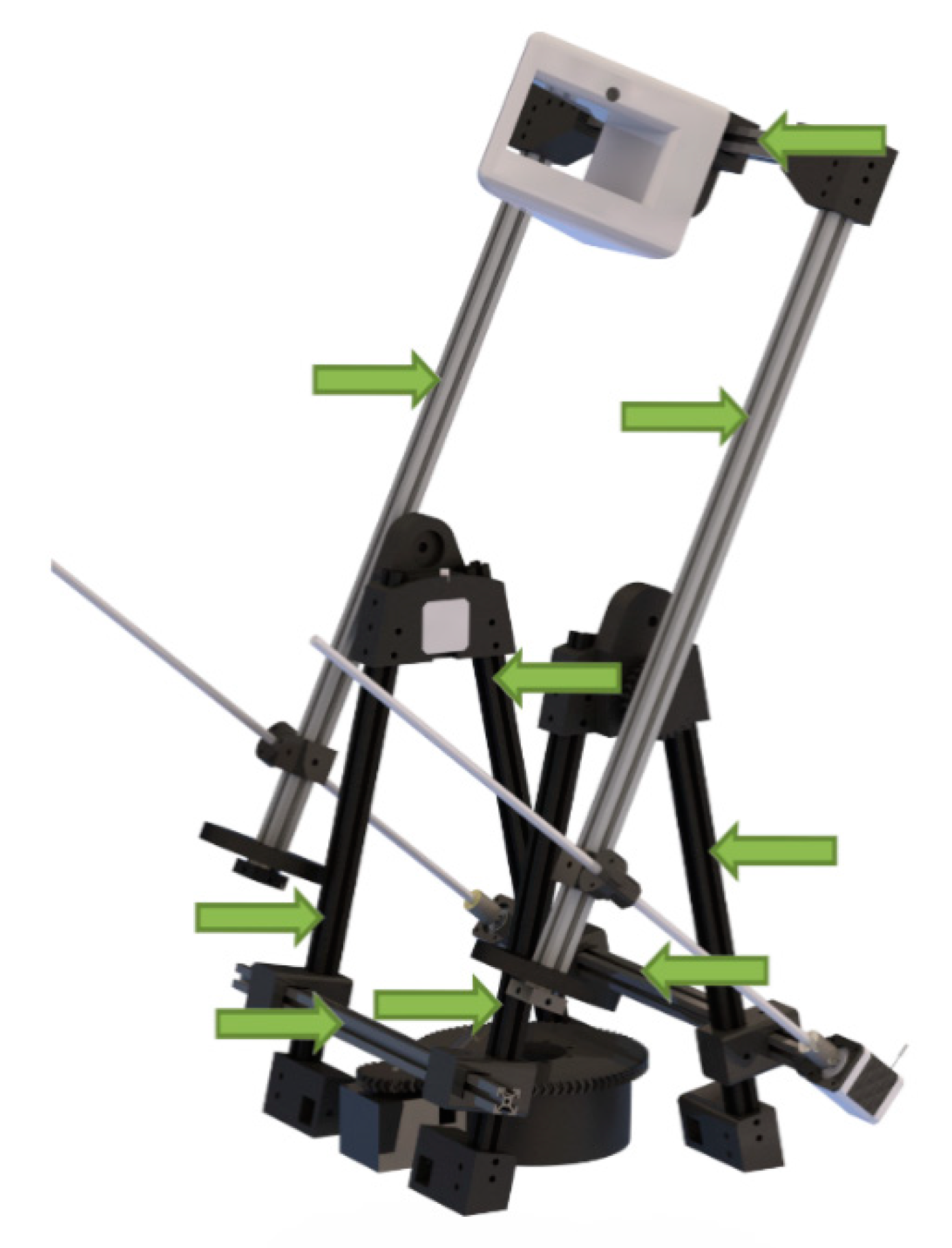




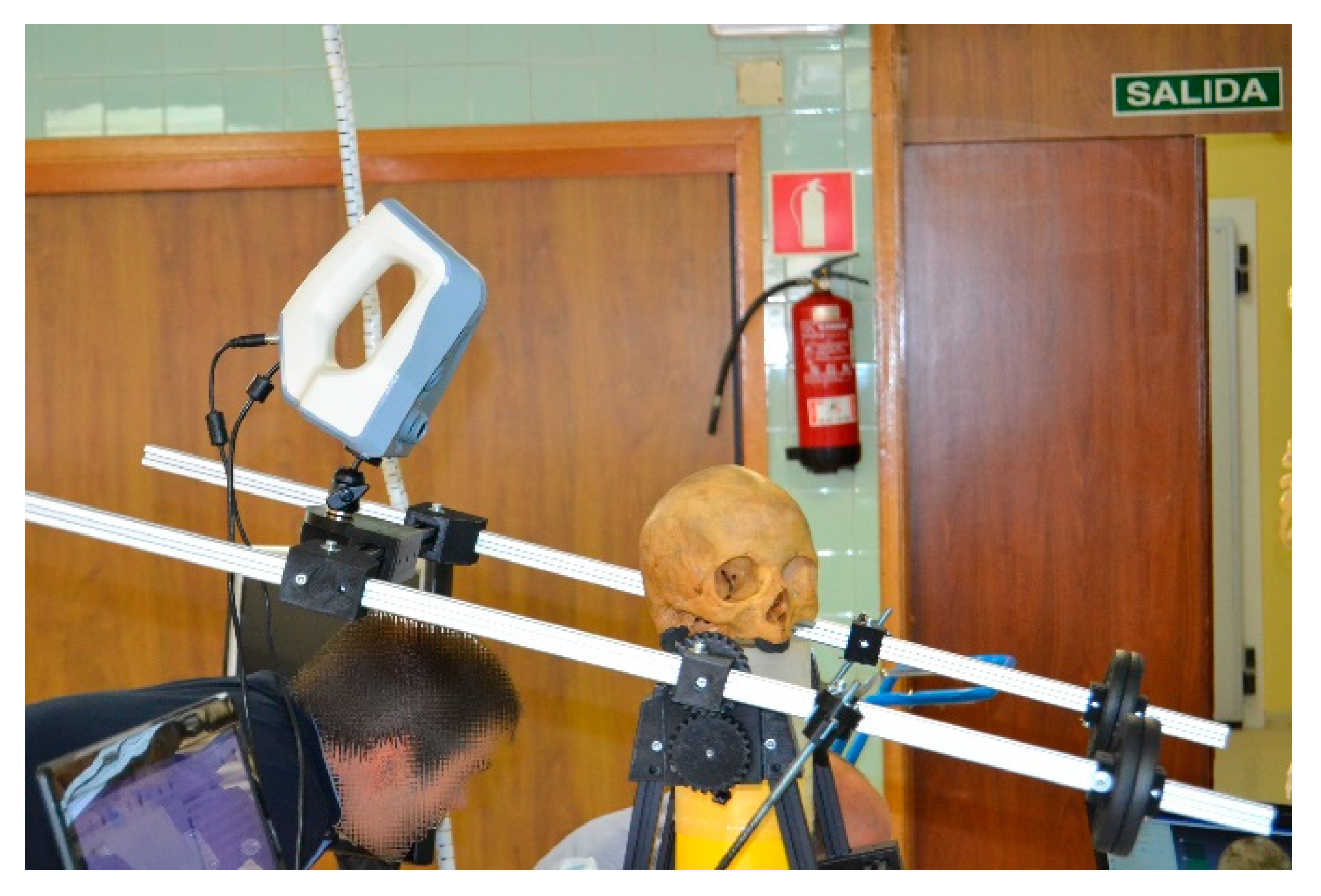


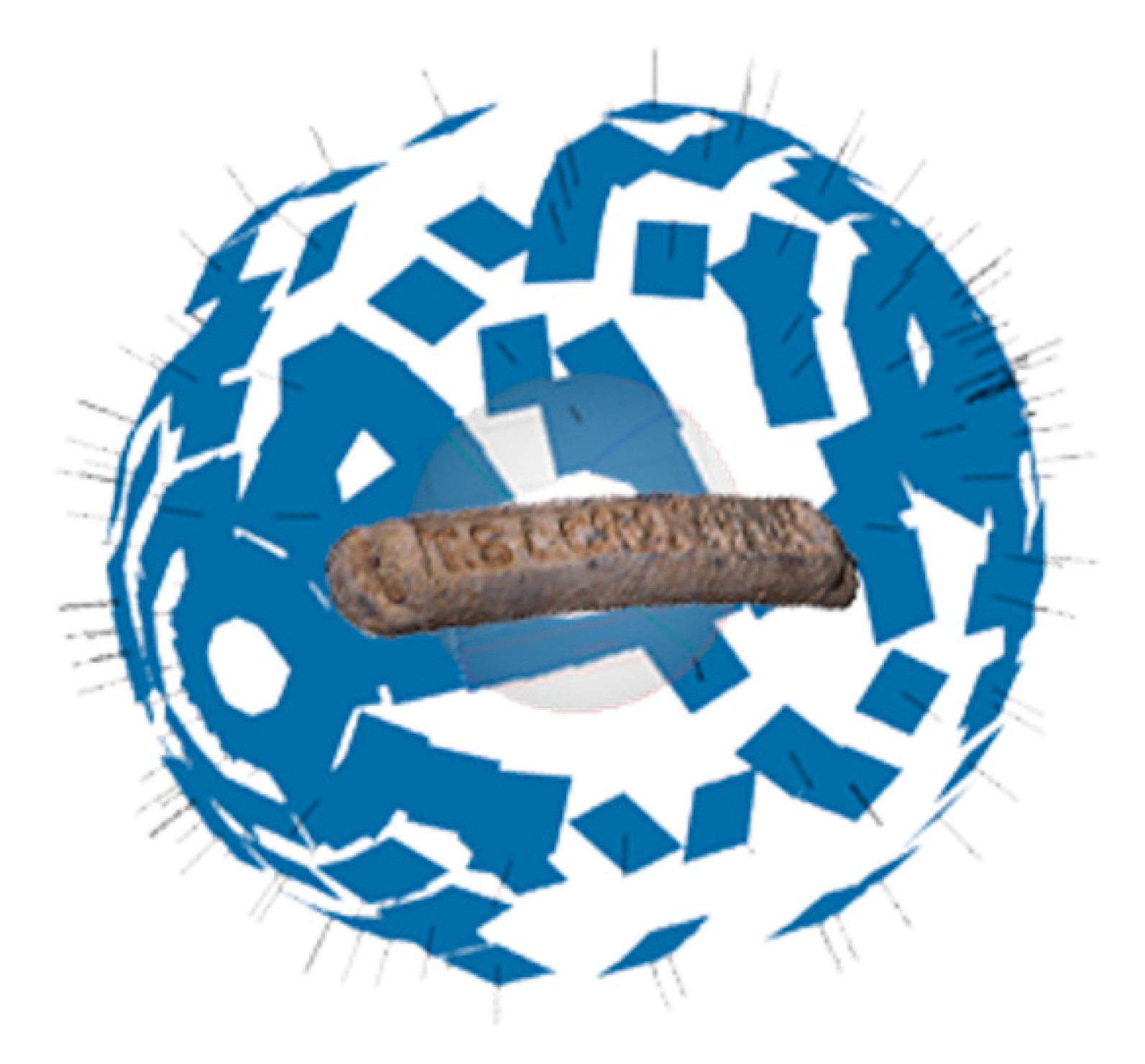

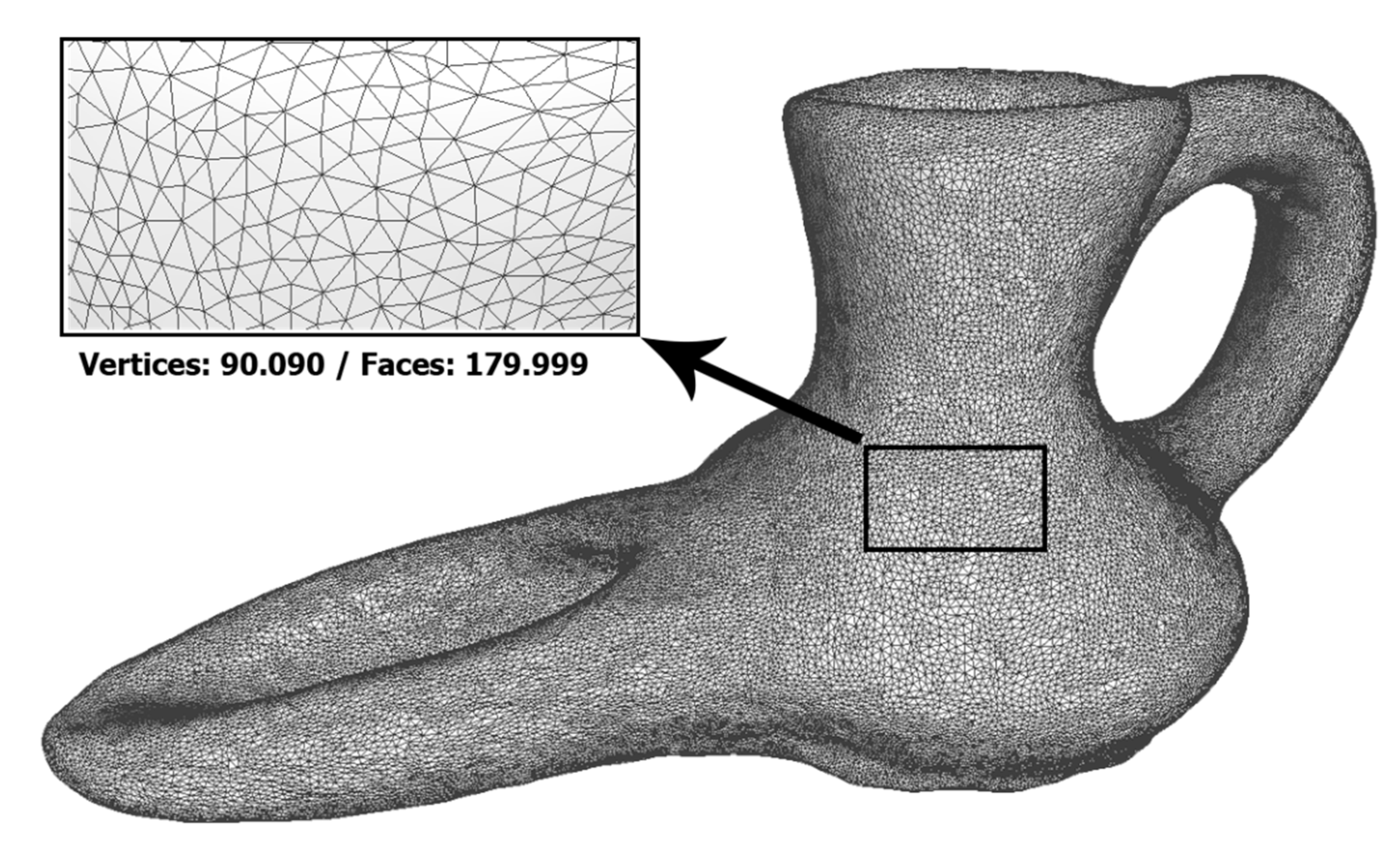



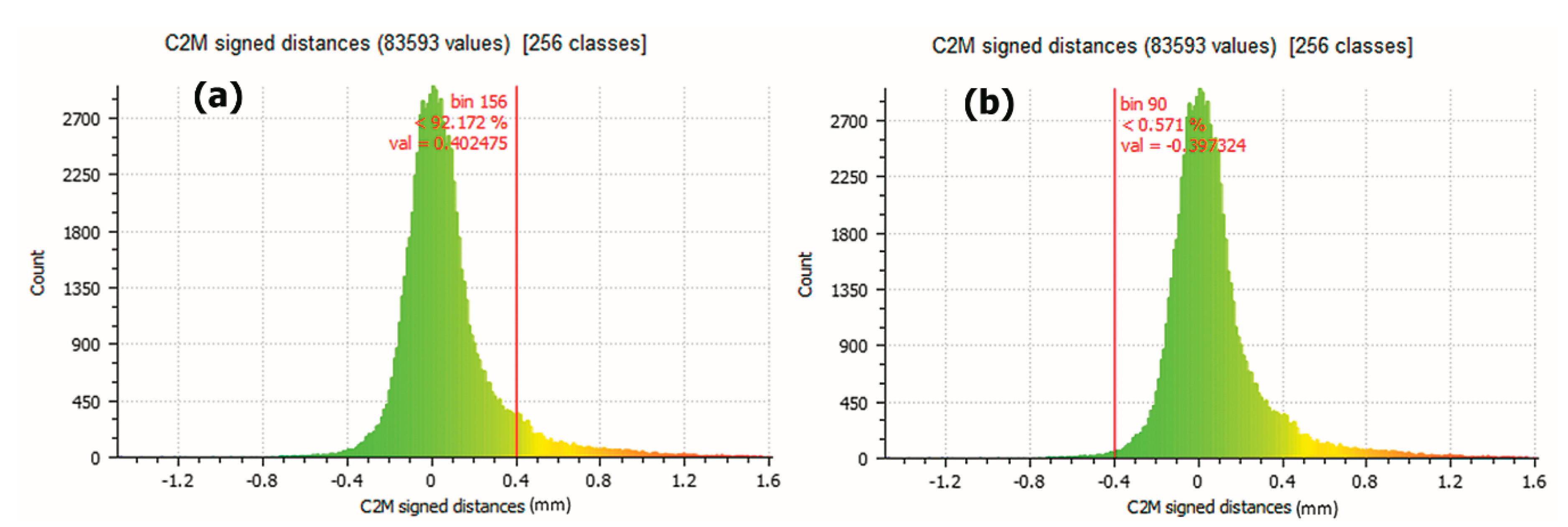

Publisher’s Note: MDPI stays neutral with regard to jurisdictional claims in published maps and institutional affiliations. |
© 2021 by the authors. Licensee MDPI, Basel, Switzerland. This article is an open access article distributed under the terms and conditions of the Creative Commons Attribution (CC BY) license (https://creativecommons.org/licenses/by/4.0/).
Share and Cite
González-Merino, R.; Sánchez-López, E.; Romero, P.E.; Rodero, J.; Hidalgo-Fernández, R.E. Low-Cost Prototype to Automate the 3D Digitization of Pieces: An Application Example and Comparison. Sensors 2021, 21, 2580. https://doi.org/10.3390/s21082580
González-Merino R, Sánchez-López E, Romero PE, Rodero J, Hidalgo-Fernández RE. Low-Cost Prototype to Automate the 3D Digitization of Pieces: An Application Example and Comparison. Sensors. 2021; 21(8):2580. https://doi.org/10.3390/s21082580
Chicago/Turabian StyleGonzález-Merino, Ramón, Elena Sánchez-López, Pablo E. Romero, Jesús Rodero, and Rafael E. Hidalgo-Fernández. 2021. "Low-Cost Prototype to Automate the 3D Digitization of Pieces: An Application Example and Comparison" Sensors 21, no. 8: 2580. https://doi.org/10.3390/s21082580
APA StyleGonzález-Merino, R., Sánchez-López, E., Romero, P. E., Rodero, J., & Hidalgo-Fernández, R. E. (2021). Low-Cost Prototype to Automate the 3D Digitization of Pieces: An Application Example and Comparison. Sensors, 21(8), 2580. https://doi.org/10.3390/s21082580







